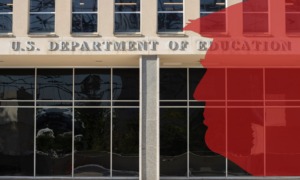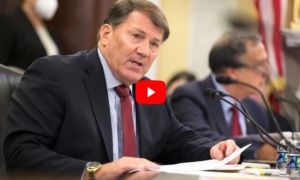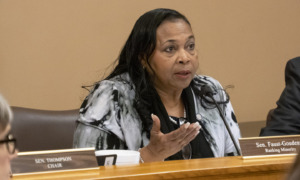This story was produced by The 74, a non-profit, independent news organization focused on education in America.
This summer parents were supposed to have a bit more financial breathing room while their children were out of school. The government rolled out Summer EBT, the first new federal food assistance program in decades, for its inaugural year, providing qualifying families $120 per school-aged child to help them afford groceries during the summer while going without school meals to help feed their kids.
Nearly 21 million children are eligible for the program, but there are early warning signs that many families were unable to take advantage of the benefits.
A prominent challenge is that the enrollment process was opaque and complicated enough that hundreds of thousands of families may miss out altogether, leaving hundreds of millions of dollars unclaimed and sent back to the government, according to policy consultant David Rubel, who has done extensive research on the Summer EBT program as well as its predecessor, the Pandemic EBT (P-EBT) program, which gave parents money to cover meals while children were learning remotely.
The experience for families
Erika Marquez’s family was one of many that were unable to access the funding. Marquez has four children — three of them attend school programs and one, her infant, is at home. Her husband, who she is separated from, told her that he received a letter saying that Summer EBT benefits were coming, but said he got no further instructions about how to actually claim the funds. “He didn’t know who to contact, how to contact them, or anything for that matter,” she said.
[Related: Grandfamilies disproportionately at-risk for food insecurity, advocates say]
Summers are always harder for her family to make ends meet — when her three school-age kids are home, they miss two daily meals they would have gotten for free at school. Marquez was hopeful that the Summer EBT money coming in would help cover that gap this year, but when her family couldn’t access the funds, they suffered. Marquez works full time and says that to ensure that her children have what they need, she has to follow a strict budget to cover all of their expenses, and this was a particularly difficult summer. Living in Las Vegas, Nevada, which experienced the hottest summer on record, her electricity bill went through the roof after cranking the air conditioning. Normally it costs her about $100 to $150 for the season; this summer she says it was about $400.
Without help from the new food assistance program, Marquez says she had to ignore those utility bills and prioritize groceries so that her children had enough to eat. “It’s just hard when you hear your child say, ‘Mom, my stomach is rumbling,’” she shared. “It’s more important to be able to make sure that my children are fed.” She had to skip paying for electricity for two months, landing her on a payment plan, which has added fees on top of the bill itself. Had she received Summer EBT for her three children, that would have come to $360 — almost the same cost as her electricity bill, she noted.
California missed out on $1 billion earmarked for P-EBT.
Many other parents have found themselves in a similar situation to Marquez this season. In California, according to the state’s response to a FOIA request made by Rubel, 281,690 Summer EBT cards were returned due to a wrong address and went unused between June 1 and Aug. 31. In a state where 1 in 5 residents is food insecure, this is troubling, especially given that during the pandemic
Propel, a financial technology company that helps low-income Americans with banking and public benefits, administered a survey of low-income families in August, which revealed anecdotal evidence that backs Rubel’s finding that some eligible families had trouble getting the money. The survey surfaced scattered reports of barriers to access. “No, haven’t received yet,” one respondent from Missouri wrote, adding, “It would help me not having to skip meals to feed my kids.” Another from Michigan wrote, “No, it would make a big difference. We haven’t received them yet, or the card.”
Most of the families that received Summer EBT dollars got their cards automatically through a process known as streamlined certification. States enrolled them without them having to take any action if they were on certain public benefit programs, including free and reduced price school lunch, the Supplemental Nutrition Assistance Program and the Temporary Assistance for Needy Families program. In some states, if a family already had an EBT card for SNAP benefits, for example, the money was automatically loaded onto it; other states decided to send out separate cards.
Families Must Enroll; Many Don’t
But a number of eligible families didn’t automatically receive the benefits. For example, families that don’t participate in other programs, but whose children do qualify for free and reduced price meals at school, are eligible for Summer EBT, but they must enroll, which has proven a challenge. In part, that’s because in 2020, Congress made school meals universally free so families did not need to enroll, but that expired last fall, and some parents are out of practice with signing up. In the 41 states without universal school meals, many parents are failing to sign up for free and reduced price meals, let alone Summer EBT. Meanwhile, nine states have passed universal school meals, requiring no paperwork during the school year, so parents had to know to sign up for Summer EBT separately.
Kelsey Boone, senior child nutrition policy analyst at the Food Research & Action Center, an anti-hunger nonprofit, said that, anecdotally, her organization has heard that while the streamlined application has had a lot of success getting benefits to families, states are seeing “lower than expected application return rates” for everyone else. Kansas, for example, had received more than 2,000 applications for Summer EBT by mid-September even though the Kansas Department for Children and Families estimates there are more than 100,000 families that are eligible for the program but have to enroll.
[Related: ‘It’s hard to focus’: Schools say American kids are hungry]
One problem is that some states haven’t created statewide applications specifically for Summer EBT, making it challenging for parents to figure out where and how to apply, and some have buried the applications deep in their websites. Another is that outreach to let parents know what they have to do “has not been as robust as it could be,” Boone said. She added that states don’t always have up-to-date addresses for households, particularly for low-income families who tend to move a lot, so any mail or even the EBT cards themselves may not reach parents. In at least some states, she noted, school districts weren’t even aware they had to tell parents to sign up.
The same problems plagued the P-EBT program. When summer P-EBT cards were distributed in 2022 and 2023, about $1 billion in benefits went unclaimed by eligible families, according to Rubel’s research, and about 4.5 million cards were either expunged or at risk of being expunged. Instead of conducting extensive outreach to make sure parents knew about the benefits and how to claim them, Rubel was told that:
Many state departments of education put the information on their websites and left it to parents to find it.
The problem with Summer EBT promises to be even more acute. Families had 274 days to realize they were missing out on P-EBT funds and sign up for the benefits, and if they spent at least a dollar the clock would reset, giving them another 274 days. The Summer EBT program gives families just 122 days from the date the money is loaded onto a card to spend it all before it’s forfeited and sent back to the federal government. “This is a very short window,” Rubel said. Nebraska started sending expungement letters in early September. Rubel estimates most of the money will be gone by the end of November.
Deadlines Extended, But Outreach is Needed
The good news is that states have been allowed to push application deadlines back so more families can apply and receive their money before it gets forfeited. In an email response to a question about the timeline, a USDA spokesperson said that the agency provided “additional flexibility” to allow all states that participated in the program this year to extend their application deadlines to ensure “sufficient time for applications to be submitted and processed.” The spokesperson said the agency will work with each state individually to determine the “appropriate” amount of time a state can extend a deadline.
Some states have already taken the agency up on the offer. Kansas and Oregon both announced they would push their deadlines to apply back.
But Rubel insists that school districts must do outreach to ensure eligible families get the money they’re owed before it’s too late. “They have the capacity, they have the infrastructure,” he said, adding that districts have up-to-date contact information for families. “They need to be prodded a little bit to help their families.”
It’s all the more urgent because the families that did receive Summer EBT dollars saw a huge benefit.
In Propel’s August 2024 survey, fewer families reported that they had to eat less, skip meals or were unable to buy the food they wanted as compared to August 2023. Fewer lacked household essentials, owed money on utility bills, or had their utilities shut off; fewer were evicted or lived in unstable housing. Summer EBT “was life saving,” one respondent said. “I didn’t know where my next meal was coming [from].” Another said, “It helped tremendously with groceries for me and my daughter right when we really needed it.”
“This money really can mean the difference between having food on the table and not having food on the table for a family during the summer,” Boone said.
There is a chance to fix this problem before next summer starts. First, advocates hope more states will decide to join the Summer EBT program, ensuring more families can participate. In 2024, 13 states opted out, but Alabama, for example, has already said it will join in 2025. The application window for next summer is currently open and will remain so through next August. For the states that participated this year, there are lessons to be learned about expanding accessibility. “There’s a lot of discussion about that right now,” Boone said. Some of that is about how states can improve their outreach, including putting more resources into it, trying to reach families in a multitude of ways and offering better customer service.
“So many of our problems are so hard to fix,” Rubel said. “This is a really easy one to fix.”
[Related Grant Opportunity: Farm to school program planning, education and edible garden grants]
***
Bryce Covert is an independent journalist writing about the economy. She is a contributing op-ed writer at the New York Times and a contributing writer at The Nation. Her writing has appeared in Time Magazine, the Washington Post, New York Magazine, the New Republic, Slate, and others, and she won a 2016 Exceptional Merit in Media Award from the National Women’s Political Caucus.
This story first appeared at The 74, a nonprofit news site covering education. Sign up for free newsletters from The 74 to get more like this in your inbox.
































